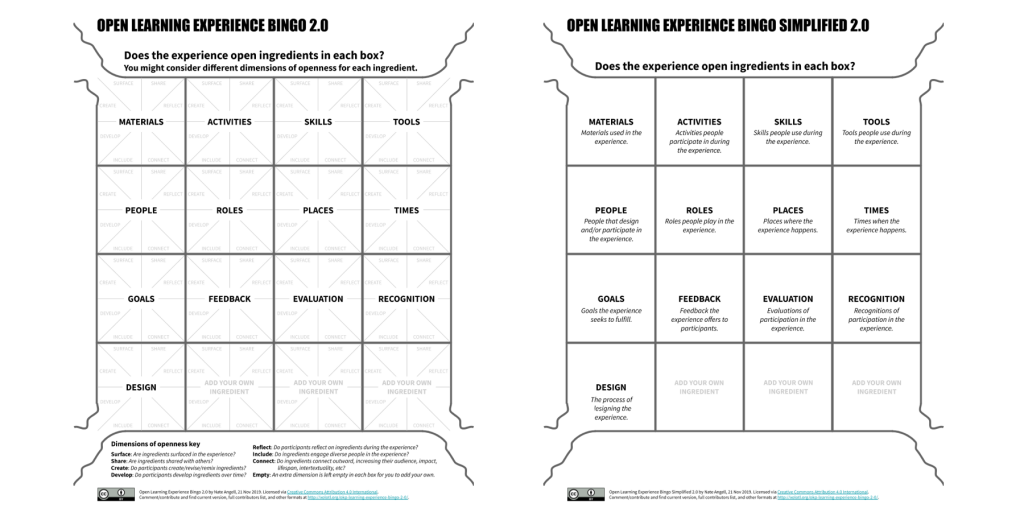Learning experience bingo is a game invented to offer a way for people to consider how learning experiences — like activities, assignments, modules, or courses — might be “opened” in various ways. For example, a learning experience might be opened by enabling wider access to more people, more agency for people involved, or more possibilities in its materials, tools, goals, outcomes, and/or design.
The full bingo card includes boxes containing possible “ingredients” in a learning experience, and radiating from the center of each box, “dimensions” of openness along which an ingredient might be opened. There are also open spaces for people to add other learning experience ingredients and/or dimensions of openness. Borders of the card are also left open in various places to suggest that the bingo card itself could be opened more.
Boxes on the bingo card represent the ingredients of learning experiences: materials, activities, skills, tools, people, roles, places, times, goals, feedback, evaluation, recognition, and design. The simple version of the bingo card is just these ingredient boxes, where you consider the openness of a learning experience in relation to each box with the answer to a simple question: Does this experience open this box of ingredients?

Dimensions of openness
Beyond the basic question of whether any particular box IS being “opened” in a learning experience, there’s the question of HOW it’s being opened.
The pie slices radiating out from each ingredient box in the full version of the card represent these dimensions of openness: surface, share, create, develop, reflect, include, connect. The dimensions radiate from the center to avoid the idea of hierarchy. An ingredient might be expanding along one dimension and not another (eg, a skill in a learning experience might be developed but not reflected upon), but the bingo card does not seek to measure whether one dimension of openness is better or more important than another. Add your own dimensions of openness starting with the pie slice left open. There’s a key to the dimensions of openness on the full bingo card itself and on the blog post that introduced it.
I offer this bingo card in hopes that people can use it as a sort of game to explore the openness of learning experiences — and perhaps generate ideas about how to open them further — rather than merely to judge how open they are like a rubric might. As I wrote before: “While the rubric was maybe attempting to answer a question like: ‘How open is this learning experience?’ I’m hoping this bingo card and its future augmentations can help people answer a fundamentally different question: ‘What dimensions of openness does this learning experience incorporate and generate?’”
You can access Google Slides versions of the full and simplified bingo cards that can be downloaded in various formats, including a PDF suitable for printing, and copied so you can make your own, revised versions.
This 2.0 version grew out of collaboration around two earlier works, the OKP Learning Experience Bingo Card 1.0 (OKPLEB 1.0) and the OKP Learning Experience Rubric 1.1 (OKPLER 1.1). Visit my blog to view all posts related to learning experience bingo, including a growing collection of applied examples, a full list of its contributors, and a dynamic collaborative bibliography of resources related to it.
Leave a Reply